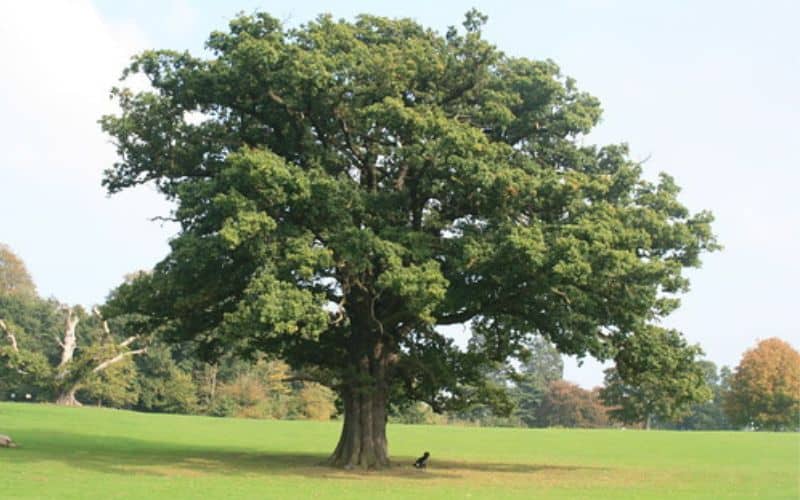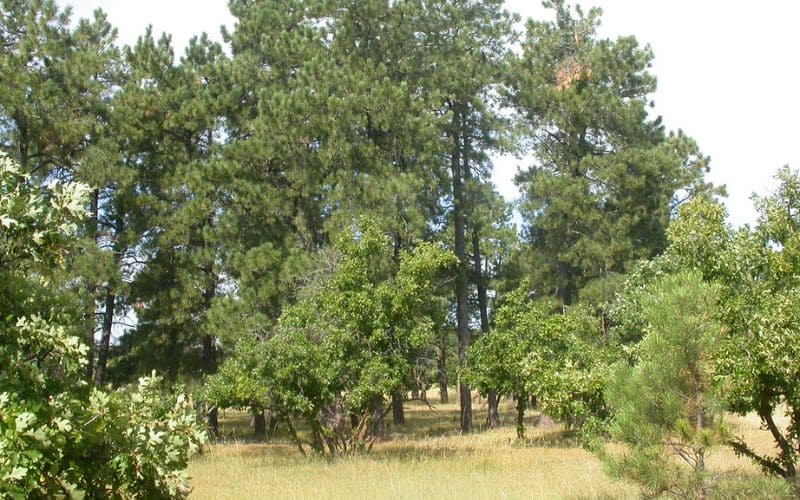
If you’ve ever taken a stroll through Ontario’s lush woodlands, you’ve likely come across the majestic Bur Oak. A native species to North America, it’s found in abundance throughout Ontario and is recognised for its resilience and long lifespan. Its imposing stature, with heights reaching up to 30 metres tall, makes it an unmissable feature of the landscape.
The Bur Oak, or Quercus macrocarpa as it’s known scientifically, carries significant importance within the ecosystem. As one of the most drought-resistant oaks out there today, it has adapted impressively well to life in various soil types – from dry ridges to moist bottoms – ensuring that wildlife continues to thrive around these ancient trees.
You might be surprised by how much history is encapsulated within each ring of a Bur Oak tree trunk; they’re capable of living for hundreds upon hundreds of years! Imagine all that these silent observers have seen during their lengthy lifespans – from subtle shifts in climate conditions over centuries right down to minute seasonal changes year on year.
Understanding the Bur Oak in Ontario
Delving into the world of oaks, you’ll find that the Bur Oak is a remarkable species. It’s one of Ontario’s native trees and holds an esteemed position within its biodiversity. Known scientifically as Quercus macrocarpa, this oak tree carries a rich history and plays an integral role in shaping Canada’s natural landscape.
Bur Oaks are known for their longevity and hardiness. They’re one of those resilient types that can endure extreme weather conditions, making them ideal for planting across various regions in Ontario. You might be fascinated to know they have an incredible lifespan too – some living up to 400 years!
Characterised by their deeply lobed leaves and large acorns capped with fringed cups (which gives them their unique name), these trees offer not just beauty but also habitat support for many creatures like squirrels and birds.
Let’s delve deeper into some stats:
| Feature | Details |
|---|---|
| Height | Can grow up to 30 meters |
| Lifespan | Around 200-400 years |
| Leaf Shape | Deeply lobed |
These figures underscore why it’s crucial we understand more about these majestic beings. Their presence contributes significantly towards maintaining ecological balance while adding charm to our surroundings.
Ontario takes pride in its diverse collection of flora, especially when it comes down to its iconic oaks like the Bur Oak – each standing tall as symbols of resilience amid changing seasons! Remember though: nurturing such biodiversity isn’t merely about appreciating nature; it also involves actively participating in preserving what makes our environment beautiful.

Characteristics of Ontario’s Bur Oak Trees
Ontario’s Bur Oak trees, native to North America and a prominent feature of the Canadian landscape, possess unique characteristics that distinguish them from other oak species. They’re widely recognised for their endurance and adaptability in various environmental conditions.
Your first interaction with a Bur Oak tree would likely be its impressive size. Mature trees can grow up to 30 metres tall, showcasing thick trunks which often span more than one metre in diameter. This sturdiness provides an ideal habitat for many bird species.
Bur Oaks have distinctive leaves as well. You’ll find these broad lobed leaves particularly appealing during autumn when they turn from dark green to vibrant yellow or brown before falling off the tree. In springtime though, you’re treated with new leaf growth along with greenish-yellow flowers that eventually form into acorns by late summer.
Now let’s talk about those acorns! Often measuring between 2-3 centimetres long, they’re enclosed within a scaly cup-like structure covering nearly three-quarters of the nut – another distinguishing characteristic of this remarkable oak variety.
In addition to being an important source of food for wildlife like squirrels and deer, these acorns play a crucial role in the reproduction cycle of this mighty oak tree too! A single mature Bur Oak can produce thousands upon thousands each year!
Not just surviving but thriving across diverse habitats is what makes Ontario’s bur oaks so fascinating! From dry hilltops to river valleys; open fields or shaded forests; rich loam soil or rocky outcrops – it seems there are few places where these resilient beauties won’t take root.
Cultivation and Care for Your Bur Oak
You’ve decided to plant a Bur Oak, an excellent choice indeed! Originating from Ontario, this mighty tree is known for its hardiness and impressive lifespan. Here’s how you can ensure it thrives in your garden.
Firstly, let’s talk about location. It’s crucial to find the perfect spot where your Bur Oak will have plenty of room to grow. Remember that these trees can reach heights of up to 30 metres! They’ll need ample sunlight too – at least six hours a day is ideal.
When planting your sapling, dig a hole twice as wide but no deeper than the root ball itself. This provides enough space for roots expansion while preventing sinking after planting. Water it well after settling in the ground but be careful not to overwater; these trees prefer their soil on the dry side!
Now onto feeding time! Regular fertilization isn’t necessary with these hardy oaks – nature does most of the work here – but if you want an extra boost in growth during its early years or recovery period post-droughts or pests’ attack then consider using slow-release granular fertilizer formulated specifically for oak trees.
Pruning isn’t usually required either unless there are diseased or damaged branches threatening overall tree health which should be cut away immediately and carefully without damaging healthy parts of your oak.
Keeping an eye out for potential problems is key too: watch out particularly against gypsy moth caterpillars who love munching on oak leaves though they’re rarely fatal if caught early.

The Role of the Bur Oak in Ontario’s Ecosystem
Have you ever stopped to consider the role that trees play in our environment? Let’s take a moment to appreciate one tree species native to Ontario, Canada – the mighty Bur Oak. With its robust structure and expansive canopy, it’s more than just a visual delight; it serves as an essential component of Ontario’s ecosystem.
Bur Oaks are known for their adaptability. They’re tough survivors that can withstand extreme weather conditions – from scorching summers to freezing winters. But why does this matter? It means they’re key players in maintaining biodiversity within their habitats. Their acorns provide food for a wide variety of wildlife such as squirrels, deer and birds.
Additionally, these resilient oaks help combat climate change by absorbing carbon dioxide from our atmosphere – nature’s very own air purifiers! This process is vital because it helps balance out greenhouse gas emissions which contribute significantly towards global warming.
But there’s more! Not only do they support wildlife and clean up after us humans, but these generous giants also contribute directly towards soil conservation efforts. Their deep root systems stabilize soils preventing erosion especially near water bodies thereby playing an instrumental part in preserving local landscapes across Ontario.
Finally let’s not forget about their aesthetic appeal either – nothing quite compares with the beauty of mature Bur Oaks standing tall against clear blue skies or cloaked under autumn hues!
Conclusion: The Value of the Bur Oak to Ontario
When you consider the value of the Bur Oak to Ontario, it’s clear that this majestic tree is more than just a beautiful feature on our landscape. With its impressive stature and hardy nature, it has proven itself as an essential part of our province’s ecological system.
Your garden or local park may be home to one or many Bur Oaks. These trees are true survivors, able to withstand harsh weather conditions and even fires due to their thick bark. They provide shelter for various wildlife species and their acorns serve as a food source for squirrels, deer and birds.
The benefits don’t stop there! If you’ve ever sat under a Bur Oak on a hot summer day, you’ll understand how these leafy giants contribute towards moderating temperature extremes by providing much-needed shade. This not only creates comfortable outdoor spaces but also helps reduce energy use in nearby buildings.
Ontario wouldn’t be quite the same without our beloved Bur Oaks:
- They increase property values with their natural beauty
- Help in soil conservation through their extensive root systems
- Actively participate in carbon sequestration contributing towards climate change mitigation
It’s evident that each tree adds considerable value at both individual level – improving quality of life -and collectively by supporting biodiversity within ecosystems across Ontario.
As we look ahead into future urban planning strategies let’s remember this resilient native species which so seamlessly merges economic gain with environmental sustainability. Let us cherish every oak standing tall today while striving towards expanding green spaces enriched by planting more indigenous trees like the mighty Bur Oak.








